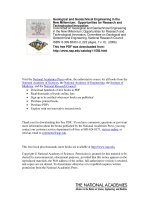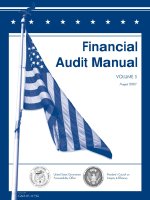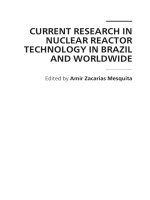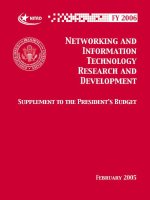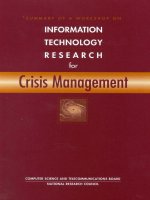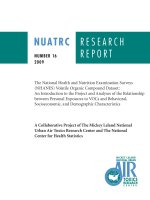INFORMATION TECHNOLOGY RESEARCH for Federal Statistics pptx
Bạn đang xem bản rút gọn của tài liệu. Xem và tải ngay bản đầy đủ của tài liệu tại đây (437.82 KB, 69 trang )
Committee on Computing and Communications Research to Enable Better
Use of Information Technology in Government
Computer Science and Telecommunications Board
Commission on Physical Sciences, Mathematics, and Applications
Committee on National Statistics
Commission on Behavioral and Social Sciences and Education
National Research Council
NATIONAL ACADEMY PRESS
Washington, D.C.
SUMMARY OF A WORKSHOP ON
INFORMATION
TECHNOLOGY
RESEARCH
for
Federal Statistics
NOTICE: The project that is the subject of this report was approved by
the Governing Board of the National Research Council, whose members
are drawn from the councils of the National Academy of Sciences, the
National Academy of Engineering, and the Institute of Medicine. The
members of the committee responsible for the report were chosen for
their special competences and with regard for appropriate balance.
Support for this project was provided by the National Science Foun-
dation under grant EIA-9809120. Support for the work of the Committee
on National Statistics is provided by a consortium of federal agencies
through a grant between the National Academy of Sciences and the
National Science Foundation (grant number SBR-9709489). Any opin-
ions, findings, conclusions, or recommendations expressed in this mate-
rial are those of the authors and do not necessarily reflect the views of the
sponsor.
International Standard Book Number 0-309-07097-X
Additional copies of this report are available from:
National Academy Press ()
2101 Constitution Ave., NW, Box 285
Washington, D.C. 20055
800-624-6242
202-334-3313 (in the Washington metropolitan area)
Copyright 2000 by the National Academy of Sciences. All rights reserved.
Printed in the United States of America
The National Academy of Sciences is a private, nonprofit, self-perpetuating soci-
ety of distinguished scholars engaged in scientific and engineering research, dedi-
cated to the furtherance of science and technology and to their use for the general
welfare. Upon the authority of the charter granted to it by the Congress in 1863,
the Academy has a mandate that requires it to advise the federal government on
scientific and technical matters. Dr. Bruce M. Alberts is president of the National
Academy of Sciences.
The National Academy of Engineering was established in 1964, under the charter
of the National Academy of Sciences, as a parallel organization of outstanding
engineers. It is autonomous in its administration and in the selection of its mem-
bers, sharing with the National Academy of Sciences the responsibility for advis-
ing the federal government. The National Academy of Engineering also sponsors
engineering programs aimed at meeting national needs, encourages education
and research, and recognizes the superior achievements of engineers. Dr. William
A. Wulf is president of the National Academy of Engineering.
The Institute of Medicine was established in 1970 by the National Academy of
Sciences to secure the services of eminent members of appropriate professions in
the examination of policy matters pertaining to the health of the public. The
Institute acts under the responsibility given to the National Academy of Sciences
by its congressional charter to be an adviser to the federal government and, upon
its own initiative, to identify issues of medical care, research, and education.
Dr. Kenneth I. Shine is president of the Institute of Medicine.
The National Research Council was organized by the National Academy of Sci-
ences in 1916 to associate the broad community of science and technology with
the Academy’s purposes of furthering knowledge and advising the federal gov-
ernment. Functioning in accordance with general policies determined by the
Academy, the Council has become the principal operating agency of both the
National Academy of Sciences and the National Academy of Engineering in pro-
viding services to the government, the public, and the scientific and engineering
communities. The Council is administered jointly by both Academies and the
Institute of Medicine. Dr. Bruce M. Alberts and Dr. William A. Wulf are chairman
and vice chairman, respectively, of the National Research Council.
National Academy of Sciences
National Academy of Engineering
Institute of Medicine
National Research Council
COMMITTEE ON COMPUTING AND COMMUNICATIONS
RESEARCH TO ENABLE BETTER USE OF INFORMATION
TECHNOLOGY IN GOVERNMENT
WILLIAM SCHERLIS, Carnegie Mellon University, Chair
W. BRUCE CROFT, University of Massachusetts at Amherst
DAVID DeWITT, University of Wisconsin at Madison
SUSAN DUMAIS, Microsoft Research
WILLIAM EDDY, Carnegie Mellon University
EVE GRUNTFEST, University of Colorado at Colorado Springs
DAVID KEHRLEIN, Governor’s Office of Emergency Services,
State of California
SALLIE KELLER-McNULTY, Los Alamos National Laboratory
MICHAEL R. NELSON, IBM Corporation
CLIFFORD NEUMAN, Information Sciences Institute, University of
Southern California
Staff
JON EISENBERG, Program Officer and Study Director
RITA GASKINS, Project Assistant (through September 1999)
DANIEL D. LLATA, Senior Project Assistant
iv
COMPUTER SCIENCE AND TELECOMMUNICATIONS BOARD
DAVID D. CLARK, Massachusetts Institute of Technology, Chair
JAMES CHIDDIX, Time Warner Cable
JOHN M. CIOFFI, Stanford University
ELAINE COHEN, University of Utah
W. BRUCE CROFT, University of Massachusetts, Amherst
A.G. FRASER, AT&T Corporation
SUSAN L. GRAHAM, University of California at Berkeley
JUDITH HEMPEL, University of California at San Francisco
JEFFREY M. JAFFE, IBM Corporation
ANNA KARLIN, University of Washington
BUTLER W. LAMPSON, Microsoft Corporation
EDWARD D. LAZOWSKA, University of Washington
DAVID LIDDLE, Interval Research
TOM M. MITCHELL, Carnegie Mellon University
DONALD NORMAN, UNext.com
RAYMOND OZZIE, Groove Networks
DAVID A. PATTERSON, University of California at Berkeley
CHARLES SIMONYI, Microsoft Corporation
BURTON SMITH, Tera Computer Company
TERRY SMITH, University of California at Santa Barbara
LEE SPROULL, New York University
MARJORY S. BLUMENTHAL, Director
HERBERT S. LIN, Senior Scientist
JERRY R. SHEEHAN, Senior Program Officer
ALAN S. INOUYE, Program Officer
JON EISENBERG, Program Officer
GAIL PRITCHARD, Program Officer
JANET BRISCOE, Office Manager
DAVID DRAKE, Project Assistant
MARGARET MARSH, Project Assistant
DAVID PADGHAM, Project Assistant
MICKELLE RODGERS RODRIGUEZ, Senior Project Assistant
SUZANNE OSSA, Senior Project Assistant
DANIEL D. LLATA, Senior Project Assistant
v
COMMISSION ON PHYSICAL SCIENCES,
MATHEMATICS, AND APPLICATIONS
PETER M. BANKS, Veridian ERIM International, Inc., Co-chair
W. CARL LINEBERGER, University of Colorado, Co-chair
WILLIAM F. BALLHAUS, JR., Lockheed Martin Corporation
SHIRLEY CHIANG, University of California at Davis
MARSHALL H. COHEN, California Institute of Technology
RONALD G. DOUGLAS, Texas A&M University
SAMUEL H. FULLER, Analog Devices, Inc.
JERRY P. GOLLUB, Haverford College
MICHAEL F. GOODCHILD, University of California at Santa Barbara
MARTHA P. HAYNES, Cornell University
WESLEY T. HUNTRESS, JR., Carnegie Institution
CAROL M. JANTZEN, Westinghouse Savannah River Company
PAUL G. KAMINSKI, Technovation, Inc.
KENNETH H. KELLER, University of Minnesota
JOHN R. KREICK, Sanders, a Lockheed Martin Company (retired)
MARSHA I. LESTER, University of Pennsylvania
DUSA M. McDUFF, State University of New York at Stony Brook
JANET L. NORWOOD, Former Commissioner, U.S. Bureau of Labor
Statistics
M. ELISABETH PATÉ-CORNELL, Stanford University
NICHOLAS P. SAMIOS, Brookhaven National Laboratory
ROBERT J. SPINRAD, Xerox PARC (retired)
MYRON F. UMAN, Acting Executive Director
vi
COMMITTEE ON NATIONAL STATISTICS
JOHN E. ROLPH, University of Southern California, Chair
JOSEPH G. ALTONJI, Northwestern University
LAWRENCE D. BROWN, University of Pennsylvania
JULIE DAVANZO, RAND, Santa Monica, California
WILLIAM F. EDDY, Carnegie Mellon University
HERMANN HABERMANN, United Nations, New York
WILLIAM D. KALSBEEK, University of North Carolina
RODERICK J.A. LITTLE, University of Michigan
THOMAS A. LOUIS, University of Minnesota
CHARLES F. MANSKI, Northwestern University
EDWARD B. PERRIN, University of Washington
FRANCISCO J. SAMANIEGO, University of California at Davis
RICHARD L. SCHMALENSEE, Massachusetts Institute of Technology
MATTHEW D. SHAPIRO, University of Michigan
ANDREW A. WHITE, Director
vii
viii
COMMISSION ON BEHAVIORAL AND SOCIAL SCIENCES
AND EDUCATION
NEIL J. SMELSER, Center for Advanced Study in the Behavioral
Sciences, Stanford, Chair
ALFRED BLUMSTEIN, Carnegie Mellon University
JACQUELYNNE ECCLES, University of Michigan
STEPHEN E. FIENBERG, Carnegie Mellon University
BARUCH FISCHHOFF, Carnegie Mellon University
JOHN F. GEWEKE, University of Iowa
ELEANOR E. MACCOBY, Stanford University
CORA B. MARRETT, University of Massachusetts
BARBARA J. McNEIL, Harvard Medical School
ROBERT A. MOFFITT, Johns Hopkins University
RICHARD J. MURNANE, Harvard University
T. PAUL SCHULTZ, Yale University
KENNETH A. SHEPSLE, Harvard University
RICHARD M. SHIFFRIN, Indiana University
BURTON H. SINGER, Princeton University
CATHERINE E. SNOW, Harvard University
MARTA TIENDA, Princeton University
BARBARA TORREY, Executive Director
Preface
As part of its new Digital Government program, the National Science
Foundation (NSF) requested that the Computer Science and Telecommu-
nications Board (CSTB) undertake an in-depth study of how information
technology research and development could more effectively support
advances in the use of information technology (IT) in government. CSTB’s
Committee on Computing and Communications Research to Enable Better
Use of Information Technology in Government was established to orga-
nize two specific application-area workshops and conduct a broader
study, drawing in part on those workshops, of how IT research can enable
improved and new government services, operations, and interactions with
citizens.
The committee was asked to identify ways to foster interaction among
computing and communications researchers, federal managers, and pro-
fessionals in specific domains that could lead to collaborative research
efforts. By establishing research links between these communities and
creating collaborative mechanisms aimed at meeting relevant require-
ments, NSF hopes to stimulate thinking in the computing and communi-
cations research community and throughout government about possibili-
ties for advances in technology that will support a variety of digital
initiatives by the government.
The first phase of the project focused on two illustrative application
areas that are inherently governmental in nature—crisis management and
federal statistics. In each of these areas, the study committee convened a
workshop designed to facilitate interaction between stakeholders from
ix
x PREFACE
the individual domains and researchers in computing and communica-
tions systems and to explore research topics that might be of relevance
government-wide. The first workshop in the series explored information
technology research for crisis management.
1
The second workshop, called
“Information Technology Research for Federal Statistics” and held on
February 9 and 10, 1999, in Washington, D.C., is summarized in this
report.
Participants in the second workshop, which explored IT research
opportunities of relevance to the collection, analysis, and dissemination
of federal statistics, were drawn from a number of communities: IT
research, IT research management, federal statistics, and academic statis-
tics (see the appendix for the full agenda of the workshop and a list of
participants). The workshop provided an opportunity for these commu-
nities to interact and to learn how they might collaborate more effectively
in developing improved systems to support federal statistics. Two key-
note speeches provided a foundation by describing developments in the
statistics and information technology research communities. The first
panel presented four case studies. Other panels then explored a range of
ways in which IT is currently used in the federal statistical enterprise and
articulated a set of challenges and opportunities for IT research in the
collection, analysis, and dissemination of federal statistics. At the conclu-
sion of the workshop, a set of parallel breakout sessions was held to
permit workshop participants to look into opportunities for collaborative
research between the IT and statistics communities and to identify some
important research topics. This report is based on those presentations
and discussions.
Because the development of specific requirements would of course be
beyond the scope of a single workshop, this report cannot presume to be a
comprehensive analysis of IT requirements in the federal statistical system.
Nor does the report explore all aspects of the work of the federal statistical
community. For example, the workshop did not specifically address the
decennial census. Presentations and discussions focused on individual or
household surveys; other surveys depend on data obtained from business
and other organizations where there would, for example, be less emphasis
on developing better survey interview instruments because the information
is in many cases already being collected through automated systems. Be-
cause the workshop emphasized survey work in the federal statistical sys-
tem, the report does not specifically address the full range of statistics appli-
cations that arise in the work of the federal government (e.g., biostatistical
1
Computer Science and Telecommunications Board, National Research Council. 1999.
Summary of a Workshop on Information Technology Research for Crisis Management. National
Academy Press, Washington, D.C.
PREFACE xi
work at the National Institutes of Health). However, by examining a repre-
sentative range of IT applications, and through discussions between IT re-
searchers and statistics professionals, the workshop was able to identify key
issues that arise in the application of IT to federal statistics work and to
explore possible research opportunities.
This report is an overview by the committee of topics covered and
issues raised at the workshop. Where possible, related issues raised at
various points during the workshop have been consolidated. In prepar-
ing the report, the committee drew on the contributions of speakers,
panelists, and participants, who together richly illustrated the role of IT in
federal statistics, issues surrounding its use, possible research opportuni-
ties, and process and implementation issues related to such research. To
these contributions the committee added some context-setting material
and examples. The report remains, however, primarily an account of the
presentations and discussions at the workshop. Synthesis of the work-
shop experience into a more general, broader set of findings and recom-
mendations for IT research in the digital government context was deferred
to the second phase of the committee’s work. This second phase is draw-
ing on information from the two workshops, as well as from additional
briefings and other work on the topic of digital government, to develop a
final report that will provide recommendations for refining the NSF’s
Digital Government program and stimulating IT innovation more broadly
across government.
Support for this project came from NSF, and the committee acknowl-
edges Larry Brandt of the NSF for his encouragement of this effort. The
National Research Council’s Committee on National Statistics, CNSTAT,
was a cosponsor of this workshop and provided additional resources in
support of the project. This is a reporting of workshop discussions, and
the committee thanks all participants for the insights they contributed
through their workshop presentations, discussions, breakout sessions, and
subsequent interactions. The committee also wishes to thank the CSTB
staff for their assistance with the workshop and the preparation of the
report. In particular, the committee thanks Jon Eisenberg, CSTB program
officer, who made significant contributions to the organization of the
workshop and the assembly of the report, which could not have been
written without his help and facilitation. Jane Bortnick Griffith played a
key role during her term as interim CSTB director in helping conceive and
initiate this project. In addition, the committee thanks Daniel Llata for his
contributions in preparing the report for publication. The committee also
thanks Andy White from the National Research Council’s Commission on
Behavioral and Social Sciences and Education for his support and assis-
tance with this project. Finally, the committee is grateful to the reviewers
for helping to sharpen and improve the report through their comments.
Responsibility for the report remains with the committee.
Acknowledgment of Reviewers
This report was reviewed by individuals chosen for their diverse
perspectives and technical expertise, in accordance with the procedures
approved by the National Research Council’s (NRC’s) Report Review
Committee. The purpose of this independent review is to provide candid
and critical comments that will assist the authors and the NRC in making
the published report as sound as possible and to ensure that the report
meets institutional standards for objectivity, evidence, and responsive-
ness to the study charge. The contents of the review comments and draft
manuscript remain confidential to protect the integrity of the deliberative
process. We wish to thank the following individuals for their participa-
tion in the review of this report:
Larry Brown, University of Pennsylvania,
Terrence Ireland, Consultant,
Diane Lambert, Bell Laboratories, Lucent Technologies,
Judith Lessler, Research Triangle Institute,
Teresa Lunt, SRI International,
Janet Norwood, Former Commissioner, U.S. Bureau of Labor Statistics,
Bruce Trumbo, California State University at Hayward, and
Ben Schneiderman, University of Maryland.
Although the individuals listed above provided many constructive
comments and suggestions, responsibility for the final content of this
report rests solely with the study committee and the NRC.
xiii
Contents
1 INTRODUCTION AND CONTEXT 1
Overview of Federal Statistics, 1
Activities of the Federal Statistics Agencies, 2
Data Collection, 3
Processing and Analysis, 7
Creation and Dissemination of Statistical Products, 9
Organization of the Federal Statistical System, 10
Information Technology Innovation in Federal Statistics, 14
2 RESEARCH OPPORTUNITIES 17
Human-Computer Interaction, 17
User Focus, 19
Universal Access, 19
Literacy, Visualization, and Perception, 20
Database Systems, 23
Data Mining, 25
Metadata, 29
Information Integration, 30
Survey Instruments, 31
Limiting Disclosure, 34
Trustworthiness of Information Systems, 41
xv
xvi CONTENTS
3 INTERACTIONS FOR INFORMATION TECHNOLOGY
INNOVATION IN FEDERAL STATISTICAL WORK 44
APPENDIX
WORKSHOP AGENDA AND PARTICIPANTS 49
1
1
Introduction and Context
OVERVIEW OF FEDERAL STATISTICS
Federal statistics play a key role in a wide range of policy, business,
and individual decisions that are made based on statistics produced about
population characteristics, the economy, health, education, crime, and
other factors. The decennial census population counts—along with re-
lated estimates that are produced during the intervening years—will drive
the allocation of roughly $180 billion in federal funding annually to state
and local governments.
1
These counts also drive the apportionment of
legislative districts at the local, state, and federal levels. Another statistic,
the Consumer Price Index, is used to adjust wages, retirement benefits,
and other spending, both public and private. Federal statistical data also
provide insight into the status, well-being, and activities of the U.S. popu-
lation, including its health, the incidence of crime, unemployment and
other dimensions of the labor force, and the nature of long-distance travel.
The surveys conducted to derive this information (see the next section for
examples) are extensive undertakings that involve the collection of de-
tailed information, often from large numbers of respondents.
The federal statistical system involves about 70 government agencies.
Most executive branch departments are, in one way or another, involved
1
U.S. Census Bureau estimate from U.S. Census Bureau, Department of Commerce. 1999.
United States Census 2000: Frequently Asked Questions. U.S. Census Bureau, Washington,
D.C. Available online at < />2 INFORMATION TECHNOLOGY RESEARCH FOR FEDERAL STATISTICS
2
Estimate by Census Bureau director of total costs in D’Vera Cohn. 2000. “Early Signs of
Census Avoidance,” Washington Post, April 2, p. A8.
3
For more details on federal statistical programs, see Executive Office of the President,
Office of Management and Budget (OMB). 1998. Statistical Programs of the United States
Government. OMB, Washington, D.C.
in gathering and disseminating statistical information. The two largest
statistical agencies are the Bureau of the Census (in the Department of
Commerce) and the Bureau of Labor Statistics (in the Department of
Labor). About a dozen agencies have statistics as their principal line of
work, while others collect statistics in conjunction with other activities,
such as administering a program benefit (e.g., the Health Care Financing
Administration or the Social Security Administration) or promulgating
regulations in a particular area (e.g., the Environmental Protection
Agency). The budgets for all of these activities—excluding the estimated
$6.8 billion cost of the decennial census
2
—total more than $3 billion per
year.
3
These federal statistical agencies are characterized not only by their
mission of collecting statistical information but also by their indepen-
dence and commitment to a set of principles and practices aimed at ensur-
ing the quality and credibility of the statistical information they provide
(Box 1.1). Thus, the agencies aim to live up to citizens’ expectations for
trustworthiness, so that citizens will continue to participate in statistical
surveys, and to the expectations of decision makers, who rely on the
integrity of the statistical products they use in policy formulation.
ACTIVITIES OF THE FEDERAL STATISTICS AGENCIES
Many activities take place in connection with the development of
federal statistics—the planning and design of surveys (see Box 1.2 for
examples of such surveys); data collection, processing, and analysis; and
the dissemination of results in a variety of forms to a range of users. What
follows is not intended as a comprehensive discussion of the tasks in-
volved in creating statistical products; rather, it is provided as an outline
of the types of tasks that must be performed in the course of a federal
statistical survey. Because the report as a whole focuses on information
technology (IT) research opportunities, this section emphasizes the IT-
related aspects of these activities and provides pointers to pertinent dis-
cussions of research opportunities in Chapter 2.
INTRODUCTION AND CONTEXT 3
BOX 1.1
Principles and Practices for a Federal Statistical Agency
In response to requests for advice on what constitutes an effective federal sta-
tistical agency, the National Research Council’s Committee on National Statistics
issued a white paper that identified the following as principles and best practices
for federal statistical agencies:
Principles
• Relevance to policy issues
• Credibility among data users
• Trust among data providers and data subjects
Practices
• A clearly defined and well-accepted mission
• A strong measure of independence
• Fair treatment of data providers
• Cooperation with data users
• Openness about the data provided
• Commitment to quality and professional standards
• Wide dissemination of data
• An active research program
• Professional advancement of staff
• Caution in conducting nonstatistical activities
• Coordination with other statistical agencies
SOURCE: Adapted from Margaret E. Martin and Miron L. Straf, eds. 1992.
Principles and
Practices for a Federal Statistical Agency.
Committee on National Statistics, National Re-
search Council. National Academy Press, Washington, D.C.
Data Collection
Data collection starts with the process of selection.
4
Ensuring that
survey samples are representative of the populations they measure is a
significant undertaking. This task entails first defining the population of
interest (e.g., the U.S. civilian noninstitutionalized population, in the case
of the National Health and Nutrition Examination Survey). Second, a
4
This discussion focuses on the process of conducting surveys of individuals. Many
surveys gather information from businesses or other organizations. In some instances,
similar interview methods are used; in others, especially with larger organizations, the data
are collected through automated processes that employ standardized reporting formats.
4 INFORMATION TECHNOLOGY RESEARCH FOR FEDERAL STATISTICS
BOX 1.2
Examples of Federal Statistical Surveys
To give workshop participants a sense of the range of activities and purposes
of federal statistical surveys, representatives of several large surveys sponsored
by federal statistical agencies were invited to present case studies at the work-
shop. Reference is made to several of these examples in the body of this report.
National Health and Nutrition Examination Survey
The National Health and Nutrition Examination Survey (NHANES) is one of
several major data collection studies sponsored by the National Center for Health
Statistics (NCHS). Under the legislative authority of the Public Health Service,
NCHS collects statistics on the nature of illness and disability in the population; on
environmental, nutritional, and other health hazards; and on health resources and
utilization of health care. NHANES has been conducted since the early 1960s; its
ninth survey is NHANES 1999.
1
It is now implemented as a continuous, annual
survey in which a sample of approximately 5,000 individuals representative of the
U.S. population is examined each year. Participants in the survey undergo a
detailed home interview and a physical examination and health and dietary inter-
views in mobile examination centers set up for the survey. Home examinations,
which include a subset of the exam components conducted at the exam center,
are offered to persons unable or unwilling to come to the center for the full exam-
ination.
The main objectives of NHANES are to estimate the prevalence of diseases
and risks factors and monitoring trends for them; to explore emerging public health
issues, such as cardiovascular disease; to correlate findings of health measures in
the survey, such as body measurements and blood characteristics, and to estab-
lish a national probability sample of DNA materials using NHANES-collected blood
samples. There are a variety of consumers for the NHANES data, including gov-
ernment agencies, state and local communities, private researchers, and compa-
nies, including health care providers. Findings from NHANES are used as the
basis for such things as the familiar growth charts for children and material on
obesity in the United States. For example, the body mass index used in under-
standing obesity is derived from NHANES data and was developed by the National
Institutes of Health in collaboration with NCHS. Other findings, such as the effects
of lead in gasoline and in paint and the effects of removing it, are also based on
NHANES data.
2
1
Earlier incarnations of the NHANES survey were called, first, the Health Examination Survey
and then, the Health and Nutrition Examination Survey (HANES). Unlike previous surveys,
NHANES 1999 is intended to be a continuous survey with ongoing data collection.
2
This description is adapted in part from documents on the National Health and Nutrition
Examination Survey Web site. (Department of Health and Human Services, Centers for Dis-
ease Control, National Center for Health Statistics (NCHS). 1999. National Health and Nutri-
tion Examination Survey. Available online at < />nhanes/nhanes.htm>.)
continued
INTRODUCTION AND CONTEXT 5
American Travel Survey
The American Travel Survey (ATS), sponsored by the Department of Transpor-
tation, tracks passenger travel throughout the United States. The first primary
objective is to obtain information about long-distance travel
3
by persons living in
the United States. The second primary objective is to inform policy makers about
the principal characteristics of travel and travelers, such as the frequency and
economic implications of long-distance travel, which are useful for a variety of
planning purposes. ATS is designed to provide reliable estimates at national and
state levels for all persons and households in the United States—frequency,
primary destinations, mode of travel (car, plane, bus, train, etc.), and purpose.
Among the other data collected by the ATS is the flow of travel between states and
between metropolitan areas.
The survey samples approximately 80,000 households in the United States
and conducts interviews with about 65,000 of them, making it the second largest
(after the decennial census) household survey conducted by federal statistical
agencies. Each household is interviewed four times in a calendar year to yield a
record of the entire year’s worth of long-distance travel; in each interview, a house-
hold is asked to recall travel that occurred in the preceding 3 months. Information
is collected by computer-assisted telephone interviewing (CATI) systems as well
as via computer-assisted personal interviewing (CAPI).
Current Population Survey
The primary goal of the Current Population Survey (CPS), sponsored by the
Bureau of Labor Statistics (BLS), is to measure the labor force. Collecting demo-
graphic and labor force information on the U.S. population age 16 and older, the
CPS is the source of the unemployment numbers reported by BLS on the first
Friday of every month. Initiated more than 50 years ago, it is the longest-running
continuous monthly survey in the United States using a statistical sample. Con-
ducted by the Census Bureau for BLS, the CPS is the largest of the Census Bureau’s
ongoing monthly surveys. It surveys about 50,000 households; the sample is
divided into eight representative subsamples. Each subsample group is inter-
viewed for a total of 8 months—in the sample for 4 consecutive months, out of the
sample during the following 8 months, and then back in the sample for another 4
consecutive months. To provide better estimates of change and reduce disconti-
nuities without overly burdening households with a long period of participation, the
survey is conducted on a rotating basis so that 75 percent of the sample is common
from month to month and 50 percent from year to year for the same month.
4
BOX 1.2 Continued
3
Long-distance is defined in the ATS as a trip of 100 miles or more. The Nationwide Personal
Transportation Survey (NPTS) collects data on daily, local passenger travel, covering all types
and modes of trips. For further information, see the Bureau of Transportation’s Web page on
the NPTS, available online at < />4
For more details on the sampling procedure, see, for example the U.S. Census Bureau.
1997.
CPS Basic Monthly Survey: Sampling.
U.S. Census Bureau, Washington, D.C. Avail-
able online at < />continued
6 INFORMATION TECHNOLOGY RESEARCH FOR FEDERAL STATISTICS
Since the survey is designed to be representative of the U.S. population, a
considerable quantity of useful information about the demographics of the U.S.
population other than labor force data can be obtained from it, including occupa-
tions and the industries in which workers are employed. An important attribute of
the CPS is that, owing to the short time required to gather the basic labor force
information, the survey can easily be supplemented with additional questions. For
example, every March, a supplement collects detailed income and work experi-
ence data, and every other February information is collected on displaced workers.
Other supplements are conducted for a variety of agencies, including the Depart-
ment of Veterans Affairs and the Department of Education.
National Crime Victimization Survey
The National Crime Victimization Survey (NCVS), sponsored by the Bureau of
Justice Statistics, is a household-based survey that collects data on the amount
and types of crime in the United States. Each year, the survey obtains data from
a nationally representative sample of approximately 43,000 households (roughly
80,000 persons). It measures the incidence of violence against individuals, includ-
ing rape, robbery, aggravated assault and simple assault, and theft directed at
individuals and households, including burglary, motor vehicle theft, and household
larceny. Other types of crimes, such as murder, kidnapping, drug abuse, prostitu-
tion, fraud, commercial burglary, and arson, are outside the scope of the survey.
The NCVS, initiated in 1972, is one of two Department of Justice measures of
crime in the United States, and it is intended to complement what is known about
crime from the Federal Bureau of Investigation’s annual compilation of information
reported to law enforcement agencies (the Uniform Crime Reports). The NCVS
serves two broad goals. First, it provides a time series tracing changes in both the
incidence of crime and the various factors associated with criminal victimization.
Second, it provides data that can be used to study particular research questions
related to criminal victimization, including the relationship of victims to offenders
and the costs of crime. Based on the survey, the Bureau of Justice Statistics
publishes annual estimates of the national crime rate.
5
BOX 1.2 Continued
5
Description adapted in part from U.S. Department of Justice, Bureau of Justice Statistics
(BJS). 1999.
Crime and Victims Statistics.
BJS, Washington, D.C. Available online at <http:/
/www.ojp.usdoj.gov/bjs/cvict.htm#ncvs>.
listing, or sample frame, is constructed. Third, a sample of appropriate
size is selected from the sampling frame. There are many challenges
associated with the construction of a truly representative sample: a
sample frame of all households may require the identification of all hous-
ing units that have been constructed since the last decennial census was
INTRODUCTION AND CONTEXT 7
5
For more on survey methodology and postsurvey editing, see, for example, Lars Lyberg
et al. 1997. Survey Measurement & Process Quality. John Wiley & Sons, New York; and
Brenda G. Cox et al. 1995. Business Survey Methods, John Wiley & Sons, New York. For
more information on computer-assisted survey information collection (CASIC), see Mick P.
Couper et al. 1998. Computer Assisted Survey Information Collection. John Wiley & Sons,
New York.
conducted. Also, when a survey is to be representative of a subpopula-
tion (e.g., when the sample must include a certain number of children
between the ages of 12 and 17), field workers may need to interview
households or individuals to select appropriate participants.
Once a set of individuals or households has been identified for a
survey, their participation must be tracked and managed, including
assignment of individuals or households to interviewers, scheduling of
telephone interviews, and follow-up with nonrespondents. A variety of
techniques, generally computer-based, are used to assist field workers in
conducting interviews (Box 1.3). Finally, data from interviews are col-
lected from individual field interviewers and field offices for processing
and analysis. Data collected from paper-and-pencil interviews, of course,
require data entry (keying) prior to further processing.
5
Processing and Analysis
Before they are included in the survey data set, data from respon-
dents are subject to editing. Responses are checked for missing items and
for internal consistency; cases that fail these checks can be referred back to
the interviewer or field office for correction. The timely transmission of
data to a location where such quality control measures can be performed
allows rapid feedback to the field and increases the likelihood that cor-
rected data can be obtained. In addition, some responses require coding
before further processing. For example, in the Current Population Sur-
vey, verbal descriptions of industry and occupation are translated into a
standardized set of codes. A variety of statistical adjustments, including
a statistical procedure known as weighting, may be applied to the data to
correct for errors in the sampling process or to impute nonresponses.
A wide variety of data-processing activities take place before statisti-
cal information products can be made available to the public. These
activities depend on database systems; relevant trends in database tech-
nologies and research are discussed in the Chapter 2 section “Database
Systems.” In addition, the processing and release of statistical data must
be managed carefully. Key statistics, such as unemployment rates, influ-
8 INFORMATION TECHNOLOGY RESEARCH FOR FEDERAL STATISTICS
BOX 1.3
Survey Interview Methods
•
Computer-Assisted Personal Interviewing (CAPI)
. In CAPI, computer soft-
ware guides the interviewer through a set of questions. Subsequent questions
may depend on answers to previous questions (e.g., a respondent will be asked
further questions about children in the household only if he/she indicates the pres-
ence of children). Questions asked may also depend on the answers given in prior
interviews (e.g., a person who reports being retired will not be repeatedly asked
about employment at the outset of each interview except to verify that he or she
has not resumed employment). Such questions, and the resulting data captured,
may also be hierarchical in nature. In a household survey, the responses from
each member of the household would be contained within a household file. The
combination of all of these possibilities can result in a very large number of possi-
ble paths through a survey instrument. CAPI software also may contain features
to support case management.
•
Computer-Assisted Telephone Interviewing (CATI)
. CATI is similar in con-
cept to CAPI but supports an interviewer working by telephone rather than inter-
viewing in person. CATI software may also contain features to support telephone-
specific case management tasks, such as call scheduling.
1
•
Computer-Assisted Self-Interviewing (CASI).
The person being interviewed
interacts directly with a computer device. This technique is used when the direct
involvement of a person conducting the interview might affect answers to sensitive
questions. For instance, audio CASI, where the respondent responds to spoken
questions, is used to gather mental health data in the NHANES.
2
The technique
can also be useful for gathering information on sexual activities and illicit drug use.
•
Paper-and-Pencil Interviewing (PAPI)
. Paper questionnaires, which pre-
date computer-aided techniques, continue to be used in some surveys. Such
questionnaires are obviously more limited in their ability to adapt or select ques-
tions based on earlier responses than the methods above, and they entail additional
work (keying in responses prior to analysis). It may still be an appropriate method
in certain cases, particularly where surveys are less complex, and it continues to
be relied on as surveys shift to computer-aided methods. PAPI questionnaires
have a smaller number of paths than computer-aided questionnaires; design and
testing are largely a matter of formulating the questions themselves.
1
The terms “CATI” and “CAPI” have specific, slightly different meanings when used by the
Census Bureau. Field interviewers using a telephone from their home and a laptop are usually
referred to as using CAPI, and only those using centralized telephone facilities are said to use
CATI.
2
The CASI technique is a subset of what is frequently referred to as computerized self-admin-
istered questionnaires, a broader category that includes data collection using Touch-Tone
phones, mail-out-and-return diskettes, or Web forms completed by the interviewee.

